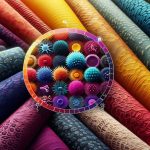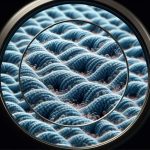You might think that antimicrobial fabrics are just another marketing gimmick, but they offer real, scientifically-backed benefits. By incorporating agents like silver ions or copper during production, these textiles actively inhibit bacterial and fungal growth. This technology doesn't just stop at promoting hygiene and comfort; it also enhances sustainability by reducing the need for frequent washing. Imagine the implications for healthcare settings and everyday use, where cleanliness and durability are paramount. Consider how antimicrobial fabrics can redefine your perception of textile hygiene and sustainability.
Table of Contents
Key Takeaways
- Antimicrobial fabrics hinder the proliferation of bacteria and fungi.
- Silver and copper ions are effective, sustainable antimicrobial agents in textiles.
- These fabrics maintain protective properties through multiple cleaning cycles.
- Antimicrobial textiles reduce odors and enhance freshness in daily use.
- They are vital in healthcare settings for infection prevention and patient safety.
Understanding Antimicrobial Fabrics
Antimicrobial textiles, commonly utilized in healthcare and athletic apparel, actively hinder the proliferation of bacteria and fungi. To comprehend how these textiles function, a solid grasp of the underlying fabric technology is crucial. By incorporating antimicrobial agents into the fibers during the production process, these textiles establish an environment that bacteria and fungi deem unwelcoming, effectively halting their growth and dissemination.
When pondering about bacteria prevention, it's vital to contemplate how these textiles sustain their effectiveness over time. Advanced fabric technology guarantees that antimicrobial characteristics aren't merely superficial but deeply integrated within the fibers. This implies that the protective attributes don't easily rinse away and persist potent through various uses and cleaning cycles.
These textiles prove exceptionally beneficial in environments where cleanliness is of utmost importance. In healthcare settings, they aid in reducing infection risks by minimizing bacterial contamination. In athletic apparel, they avert the accumulation of bacteria that cause unpleasant odors, ensuring lasting freshness.
Acquiring a thorough understanding of antimicrobial textiles empowers you with the insight to select materials that promote cleanliness, health, and overall well-being. Armed with this knowledge, you can make educated choices regarding the fabrics you incorporate into your daily routine.
Types of Antimicrobial Agents
In choosing fabrics with antimicrobial properties, you'll encounter various agents like silver ions, copper, and triclosan, each offering unique benefits and mechanisms. Silver ions are among the most effective and widely used antimicrobial agents, known for their ability to disrupt bacterial cell membranes.
Copper, a natural alternative, boasts similar properties and adds the advantage of being environmentally friendly. Triclosan, a synthetic option, inhibits bacterial growth by targeting specific enzymes but has raised environmental and health concerns.
When deciding between natural vs. synthetic options, consider both the source and the impact. Natural agents like copper and silver are often preferred for their sustainability and biodegradability. Synthetic agents, while potentially more potent, may pose risks to both the environment and human health.
Durability vs. effectiveness is another critical factor. Silver ions provide long-lasting antimicrobial action, maintaining their effectiveness through numerous washes. Copper, while durable, may see a slight reduction in efficacy over time. Triclosan, though highly effective initially, can lose its antimicrobial properties after repeated laundering.
Your choice should balance these aspects to meet your specific needs, ensuring the fabric remains both functional and safe throughout its use.
Key Benefits
You'll find that fabrics with antimicrobial properties offer several key benefits, enhancing both hygiene and overall garment longevity. These advanced fabrics are designed to provide you with a higher level of comfort and functionality, making them an excellent choice for various applications. Let's explore the primary advantages:
- Odor Control and Durability: Antimicrobial fabrics effectively combat odor-causing bacteria, ensuring your garments stay fresher for longer. This inherent odor control reduces the frequency of washing, which in turn enhances the durability of your clothing by minimizing wear and tear.
- Moisture Wicking and Comfort: These fabrics excel at moisture wicking, drawing sweat away from your skin and promoting quicker evaporation. This feature not only keeps you dry but also contributes to your overall comfort, especially during intense physical activities. The moisture-wicking capability also helps to prevent the growth of bacteria and fungi, further promoting hygiene.
- Sustainability: By extending the lifespan of your garments and reducing the need for frequent washing, antimicrobial fabrics contribute to a more sustainable lifestyle. With fewer washes, you save water, energy, and detergent, all of which have positive environmental impacts. Additionally, the longevity of these fabrics means fewer replacements, reducing textile waste.
Incorporating antimicrobial fabrics into your wardrobe offers a blend of hygiene, comfort, and sustainability, making them an excellent choice for those seeking high-performance materials.
Applications in Healthcare
Expanding beyond everyday wear, fabrics with antimicrobial properties play an essential role in healthcare settings, where they help reduce the risk of infections and improve patient outcomes. Imagine the critical areas where these fabrics make a difference: surgical gowns, scrubs, patient bedding, and curtains. These textiles are designed to inhibit the growth of harmful bacteria, making them indispensable in hospitals and clinics.
Antimicrobial fabrics are particularly valuable in surgical environments. Surgical gowns and scrubs crafted from these materials offer an extra layer of protection against hospital-acquired infections. Meanwhile, patient bedding and curtains treated with antimicrobial agents can help maintain a sterile environment, essential for both patient recovery and staff safety.
Here's a quick overview of where these fabrics are applied:
| Application | Importance | Examples |
|---|---|---|
| Surgical Gowns | Infection prevention during surgeries | Antimicrobial surgical gowns |
| Scrubs | Daily protection for healthcare workers | Antimicrobial scrubs |
| Patient Bedding | Reducing cross-contamination | Antimicrobial sheets, blankets |
| Curtains | Limiting pathogen spread in shared spaces | Antimicrobial privacy curtains |
| Patient Clothing | Ensuring patient safety and comfort | Antimicrobial hospital gowns |
Everyday Uses
Whether you're commuting, working out, or just relaxing at home, antimicrobial fabrics offer everyday benefits by keeping your clothing fresher and more hygienic. These innovative materials are becoming necessary in various aspects of daily life. Let's explore how you can integrate them into your routine:
- Athletic Wear:
When you exercise, your clothes are exposed to sweat and bacteria. Antimicrobial athletic wear helps prevent unpleasant odors and reduces the risk of skin infections, ensuring you stay comfortable and confident during your workouts.
- Home Textiles:
Your home is a sanctuary, and maintaining a clean environment is essential. Antimicrobial home textiles, such as towels and dishcloths, resist bacterial growth, minimizing the spread of germs and keeping your living space healthier.
- Bedding and Work Uniforms:
High-quality sleep is important for performance and well-being. Antimicrobial bedding ensures a clean, germ-free sleeping environment, reducing allergies and skin irritations. Furthermore, antimicrobial work uniforms are indispensable for those in high-contact professions, as they help protect against bacteria and maintain a professional appearance.
Frequently Asked Questions
How Do Antimicrobial Fabrics Impact Environmental Sustainability?
When it comes to environmental sustainability, antimicrobial fabrics are a double-edged sword. They promote sustainable manufacturing and biodegradability but can also contribute to microplastic pollution. However, with strong recycling initiatives, you can mitigate these impacts effectively.
Are There Any Potential Health Risks Associated With Antimicrobial Fabrics?
You might wonder about health concerns with antimicrobial fabrics. They can cause skin irritation and other issues. Always check if antimicrobial textiles are safe for prolonged use to avoid potential health risks.
How Should Antimicrobial Fabrics Be Washed and Maintained?
To sustain your fabric's charm lasts, follow proper care. For longevity, adhere to specific washing instructions: cold water, mild detergent, gentle cycles. Fabric maintenance includes avoiding bleach and high heat. Your diligence sustains enduring quality.
Do Antimicrobial Properties Diminish Over Time With Regular Use?
You're probably wondering if long-term efficacy diminishes with regular use. Yes, it can. Over time, material degradation occurs, which reduces effectiveness. Proper care helps, but no material retains its properties indefinitely without some loss.
Are Antimicrobial Fabrics Effective Against All Types of Bacteria and Viruses?
Are antimicrobial fabrics effective against all types of bacteria and viruses? Frequently, fabric technology and innovation can't combat all bacteria and viruses due to antimicrobial resistance. The efficacy varies, so don't assume universal protection.
- Tetron Fabric for Marine Applications: Durability and Use Cases - June 18, 2025
- Tetron Fabric for Outdoor Furniture: Weather Resistance and Care - June 18, 2025
- Tetron Fabric for Wall Coverings: Style and Application Tips - June 18, 2025







